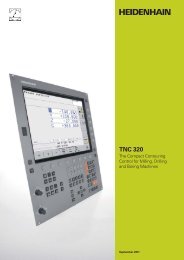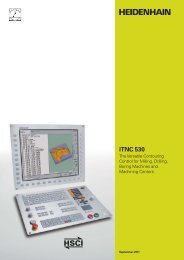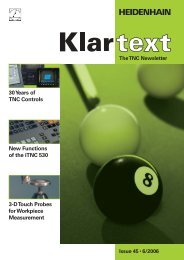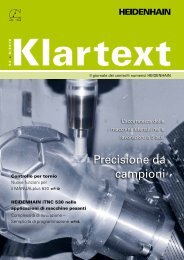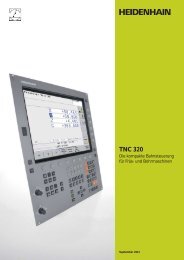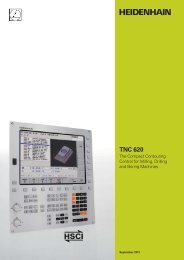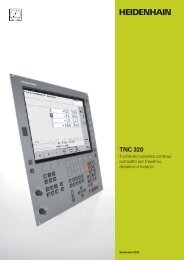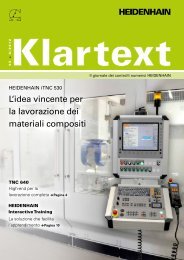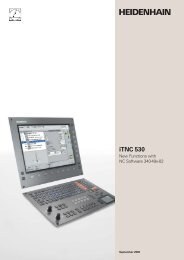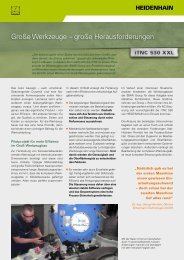Klartext 47 - TNC 640 - Heidenhain
Klartext 47 - TNC 640 - Heidenhain
Klartext 47 - TNC 640 - Heidenhain
You also want an ePaper? Increase the reach of your titles
YUMPU automatically turns print PDFs into web optimized ePapers that Google loves.
<strong>Klartext</strong> + Issue <strong>47</strong> + 09/2007 1<br />
Safety is becoming increasingly important<br />
in machine and plant construction.<br />
These measures mainly serve to protect<br />
human beings, but material assets<br />
and the environment are also receiving<br />
more consideration.<br />
Safety-Related Control<br />
Technology for<br />
Machine Tools<br />
The goal of functional safety is to minimize<br />
or at least reduce the risks that<br />
can occur during normal or impaired<br />
operation of machines or facilities.<br />
The first step of this is achieved with<br />
redundant systems. For example, axes<br />
that are moved in safety-oriented applications<br />
require redundant position<br />
information in order to perform the<br />
corresponding safety functions.<br />
Basic principle<br />
The controls and position encoders<br />
from HEIDENHAIN with functional<br />
safety meet safety integrity level 2<br />
(SIL 2) as per the IEC 61 508 standard,<br />
as well as the performance level “d”<br />
as per ISO 13 849-1 (which replaced<br />
ISO 954-1). These standards describe<br />
the assessment of safety-oriented<br />
systems, for example based on the<br />
failure probabilities of integrated components<br />
and subsystems. This modular<br />
approach helps manufacturers of<br />
safety-oriented systems to implement<br />
their systems, because they can begin<br />
with prequalified subsystems. Position<br />
encoders with functional safety and the<br />
i<strong>TNC</strong> 530 with HSCI control accommodate<br />
this concept.<br />
Functional safety on machine<br />
tools<br />
HEIDENHAIN is planning on offering<br />
HSCI controls with functional safety<br />
starting in the middle of 2008. Two<br />
redundant safety channels that work<br />
independently of each other are the<br />
foundation for controls with functional<br />
safety. All safety-relevant signals are<br />
captured, processed and output via<br />
two channels. Errors are detected by<br />
mutual comparison of the states and<br />
data in the two channels. This way, the<br />
occurrence of just one error in the control<br />
does not lead to the safety functions<br />
being incapacitated.<br />
The goal is to make actions by the<br />
machine operator at machining centers<br />
possible during automated production<br />
runs, even when protective measures<br />
are not in effect (such as protective<br />
doors being open), without danger to<br />
the operator:<br />
• Setup<br />
• Manual intervention<br />
• Process monitoring<br />
Safety-related operating modes<br />
HEIDENHAIN controls with functional<br />
safety offer four safety-related operating<br />
modes as per the EN 12 417 standard<br />
(Machine Tools–Safety–Machining<br />
Centers).<br />
Operating mode 1<br />
Automated or production mode<br />
• Operation only with closed<br />
protective door<br />
• No machine motion possible if<br />
protective door is open<br />
Operating mode 2<br />
Set-up mode<br />
• Operation with open protective<br />
doors<br />
• Axis motions of 2 m/min at most<br />
• Spindle stop within 2 revolutions<br />
• Only one axis can be moved at a<br />
time (no interpolating motions)<br />
• Spindle rotation only possible<br />
with permissive button<br />
Operating mode 3<br />
Manual intervention<br />
• Operation with open protective<br />
doors<br />
• Axis motions of 5 m/min at most<br />
• Spindle stop within 5 revolutions<br />
• More than one axis can be moved<br />
at a time (interpolating motions)<br />
• Spindle rotation only possible with<br />
permissive button<br />
Operating mode 4<br />
Advanced manual intervention,<br />
process monitoring<br />
• Operation with open protective<br />
doors<br />
• Axis motions of 5 m/min at most<br />
• Spindle stop within 5 revolutions<br />
• More than one axis can be moved<br />
at a time (interpolating motions)<br />
• Permissive button must only be<br />
pressed to start spindle rotation



